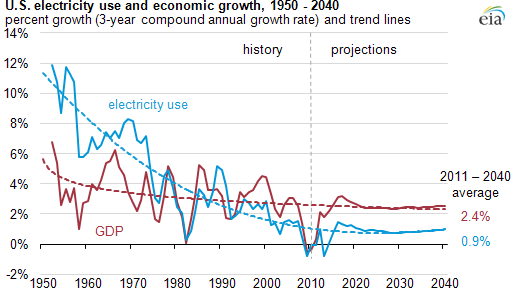- Grid Transmission and Distribution
- Transmission and Distribution
- Transmission and Distribution Systems
- Electricity Sales
- Digital Utility Strategies
- Digital Utility Strategies
- Grid Infrastructure
Hope for Utilities with Decreasing Electricity Sales

This phenomenon is seen largely in the United States, though studies show a lack of demand for electricity is also occurring in other developed countries in Europe and Asia Pacific. For example, in the European Union (EU), seven member states saw household electricity consumption fall between 2003 and 2013, generally by less than 10%. However, countries like Belgium saw a reduction in consumption of nearly one-quarter (23.9%), according to Eurostat. Among other factors, this reduction can likely be attributed in part to the use of energy-saving devices.
In Asia Pacific, Japan’s consumption of power in August fell to its lowest point since 2003, hitting just 74.6 TWh, and industry specialists expect to see a continuing decline in utility profits. The country has already begun taking steps to mitigate this by diversifying business segments and pursing other energy-related opportunities. Though these measures are technically power consumption versus electricity sales, they represent the idea that declining demand for power—especially for consumers in an economic environment that fosters less electricity usage year-over-year—is likely to challenge revenue growth for power companies.
Stagnating Electricity Sales
In the United States specifically, retail sales of electricity have stagnated, growing less than 1.5% from 2006 to 2015, according to the U.S. Energy Information Administration (EIA). However, the U.S. economy has climbed ahead, growing 11.84% between 2006 and 2015, according to the U.S. Bureau of Economic Analysis. Though this is not a vast amount of growth over a decade, in comparison to electricity sales growth, it is much more substantial; essentially, electricity sales grew at rate just higher than the rate that the GDP has grown annually. This shows that the relationship between economic growth and electricity sales is no longer connected.
(Source: U.S. Energy Information Administration)
This is challenging for utilities, as many in the United States still rely on building grid infrastructure and increasing the rate base to turn a profit. Slowed or stagnated growth in electricity demand means less need for generation, less investment in infrastructure, slower growth in the utility’s rate base, and, therefore, a threat to revenue. This is happening to utilities all around the country. ISO-New England forecasts that its region’s overall electricity demand is expected to fall by 0.2% annually over the next decade, from 128,014 GWh in 2016 to 125,213 GWh in 2025. PJM has reported that it has retired 26,000 MW of generation infrastructure since 2009, nearly 14% of its generation fleet. NYISO forecasts that energy use in its territory will decrease from 163,514 GWh to 159,382 GWh between 2013 and 2016, stating that its year-over-year growth in the overall usage of electric energy from New York’s bulk electric system is expected to flatten or decline slightly over the next decade.
Despite this challenging forecast, utilities still have options for alternative revenue streams. Utilities can begin to prioritize investments in energy efficiency and distributed energy resources (DER). By offering an integrated package of energy services to customers and becoming a service provider outside of electricity, utilities have a chance to be successful in the future, according to the Rocky Mountain Institute. In order to survive, utilities must learn to align their interests in maintaining revenue with the interests of customers who want clean, affordable energy. This idea is laid out in Guidehouse’s white paper Taking Control of Your Future: Navigating Megatrends and Tipping Points in the Utilities Industry.
